THURSDAY AT PMA
Doing the Trade Show Bump & Grind
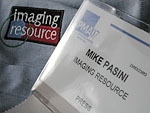 By MIKE PASINI
By MIKE PASINIEditor
The Imaging Resource Digital Photography Newsletter
LAS VEGAS, Nev. -- "What happens in Vegas," says a black T-shirt in white type, "gets Photoshopped out." PMA's in town.
Yesterday the trade show floor opened just after we'd run through the two floors of exhibits about half a mile long (making a two mile trip) taking pictures for our Ten Minute Trade Show Tour (http://www.imaging-resource.com/NEWS/1173383015.html). We barely got out alive as the throngs came through the gate.
That was the bump.
We had an early morning, grabbing a cab to the Wynn hotel for the IDC breakfast meeting (http://www.imaging-resource.com/EVENTS/PMAS07mrp/PMA07B.HTM). But it was an interesting cab ride. Our driver has a couple of digicams herself, one of which is built into a pair of binoculars. She uses them to shoot air shows, she said, "and unauthorized photos at Star Trek conventions."
She observed that her $100 gadget can now be had for about $65. We knew how she felt. Some things just can't be Photoshopped out.
CAMERABRIGHT | Back to Contents
Our first amusement on the show floor was provided at the tiny CameraBright! booth (http://www.camerabright.com). Recently LEDs have taken over the stop light business at home and if it were up to CameraBright!, they'd take over the flash business, too.
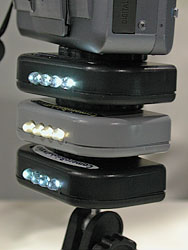
Stacked. The middle one is warmer by design.
The company makes a very small $29.95 device with four white LEDs powered by four CR2032 batteries. It has a simple power switch, screws into the camera's tripod mount and provides a tripod mount of its own. There's a warmer, yellowish version, too.
You can stack them by simply screwing another one on. Or you can mount them from a hot shoe with an optional $12.95 attachment.
The LEDs are very bright. Aimed at a subject, they don't quite illuminate them so much as contract their pupils to reduce red-eye. The company claims they're an aid to composition but we suspect they're more an aid to contrast detection focusing systems.
But CameraBright also makes a version with an extended range, ecommended for "distant subjects of when higher intensity light is needed." And one for heavier cameras (over two pounds) with a metal screw instead of plastic.
They also make a very small one for camphones that pops into the 2.5mm head phone jack, swivels and, according to the company, takes great pictures and videos.
We're a sucker for anything that keeps the flash from popping, so we'll give it a try and let you know what we think.
Digital photo frames have become affordable enough to enter the pantheon of gifts people get for Mother's Day, Father's Day, graduation and Christmas. In fact, it seems that last Christmas was the real coming out party for them. There seem to be enough in homes now that friends and visitors have seen them and want one for themselves.
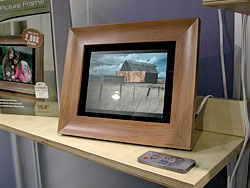
Frame with Remote
We'll be covering a number of digital photo frames companies at the show. We started with PanDigital in our DigitalFocus story (http://www.imaging-resource.com/EVENTS/PMAS07mrp/PMA07A2.HTM). Today we joined the video crew at the Smartparts booth (http://www.smartpartsproducts.com) where John Roberts introduced us to their line of frames.
For the most part, the hardware on digital frames is interchangeable. The screens come in standard sizes of 7, 8 and 10 inches with interchangeable frames. No one really builds their own. But the features (like having a card reader, larger memory capacity or WiFi) and the chipset is where the products start to diverge. Roberts said Smartparts doesn't yet have a custom chipset but they're working on it.
They distinguish their product by its ease of use, he said. Which is backed up by telephone support. They are not unfamiliar with calls from grandmothers who have just gotten a frame as a gift and don't know how to get pictures into it. Not all the people who use their frames, Roberts said, are computer literate because have of the frames they sell have been given as gifts.
So the company developed OptiPix, Windows software to make it easy to transfer pictures from a computer to the frame via USB. You delete images from the frame's built-in memory using the frame's software, but you can fill that memory with OptiPix. The software resizes images to 800x600 pixels (and sharpens them) to optimize the number you can add, too.
Once in the frame's memory or on a memory card inserted into the frame's card reader, an automatic but variable-speed slide show scrolls through every image. You use a remote control to talk to the unit.
We popped by the Lexar booth (http://www.lexar.com) to see their new stackable FireWire 800 card readers that allow for concurrent downloads from multiple cards. The readers can handle both UDMA and standard CompactFlash cards, leveraging the faster UDMA card speed.
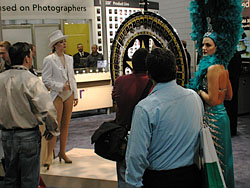
Get Lucky at Lexar
With transfer rates of 800Mb/sec (or 100MB/sec), the reader is twice as fast as a FireWire 400 drive. Available in capacities up to a massive 8-GB, UDMA cards deliver a minimum sustained write speed of 300x (45MB/sec) in all capacities.
Up to four readers can be daisy-chained together for concurrent downloads.
The UDMA 300x CompactFlash card is not just fast, though. It's bundled with a tempting software suite that includes:
- Lexar Image Rescue 3 software, which recovers most photo, video, and audio files, even if they've been erased or the card has been corrupted. The software can also reformat the card, securely delete images, and report on the overall condition of the card, so you can ensure it's in perfect working order for your next shoot.
- Lexar Backup n Sync software powered by Sharpcast (http://www.sharpcast.com) lets you backup, sync, and share your photos.
- The full version of Corel Paint Shop Pro X software to enhance, edit, and manage photos.
All software is available for free download with purchase of the card.
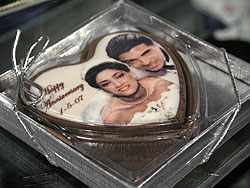
Delicious!
CHOCOLOGRAPHY | Back to Contents
It isn't new but it's still fun to watch a tray of chocolates being printed by what looks like a big inkjet printer. Chocolography (http://www.chocolateprintingcompany.com) can reproduce any picture right on the surface of the chocolate. And they're just as happy to print one as they are to print 1,000 pieces.
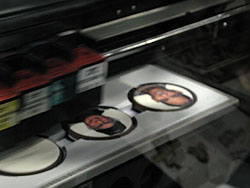
Pigment or Dye?
They have a number of designs to choose from, suitable for portraits, truffles, party favors, lollipops, boxes, coins, business cards and even trading cards.
All they require is a digital image or print plus any text message you want to appear on the chocolate.
GREEN CLEAN | Back to Contents
Chocolate are messy, though, so we headed over to the Green Clean booth (http://www.sensor-cleaning-system.info) to get a demo of their sensor cleaning system. Each trade show seems to double the number of sensor cleaning products available. Visible Dust was around early, joined by Cooper Hill and followed by Green Clean, Dust-Aid and others.
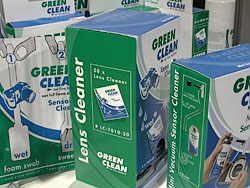
A Forest of Green
None of these solutions to the problem is inexpensive, as we've pointed out before, but it's kind of fun to see yet another way to do the job.
Green Clean's approach is to vacuum dust off the sensor with a can of compressed air and some surgical quality tubing, including a special flared nozzle you hold perpendicularly just a millimeter from the sensor's surface. A Venturi effect causes a vacuum in the tubing when you press the button on the cannister. And we're here to tell you it's quite strong suction.
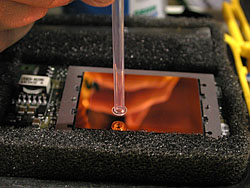
Wand at Work
If that isn't enough (because you have some lubricant or sticky residue on the sensor glass), the kit includes premoistened swabs to dissolve whatever is still on the glass. You follow up with a slightly moist spatula to absorb the excess solution, always sweeping toward the middle of the sensor, we were told during the demo. You don't want any debris to be pushed into the frame surrounding the sensor.
The big disadvantage of this system is that you can't take it on airplanes. And, as our demonstrator confessed, all gas affects the ozone layer, even safe ones like those used by Green Clean. Still, we liked that suction.
ZIGVIEW & TWIN1 | Back to Contents
We mentioned the Zigview S2 in our Sneak Peek report (http://www.imaging-resource.com/EVENTS/PMAS07mrp/PMA07A.HTM) but it's not the only product sold by Argraph (http://www.argraph.com) that we wanted to see. The company also sells an infrared wireless shutter release called the twin1.
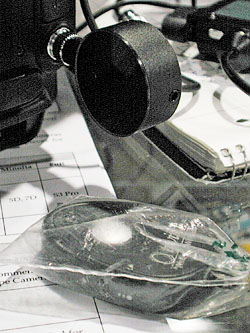
Twin1. The round receiver is plugged into the camera while the transmitter remains wrapped in plastic.
The $499.95 Zigview S2 is a miniature video camera that slides onto your dSLR's eyepiece to provide a 2.5-inch articulated LCD monitor (with 230K pixels) with a live view of your subject.
The LCD is really a display module with a shutter release, several buttons to configure the display and a video out port to redirect the signal to a monitor. It detaches from the sensing unit with which it can communicate with an optional cable that allows remote operation from 50 feet away.
It includes a programmable motion detector sensor and intervalometer. It's powered by an ENEL 5 rechargeable battery that lasts about two hours.
The Twin1 is sold in two configurations. If your camera has a built-in sensor, you can just buy the transmitter. Otherwise, you can buy the transmitter with a receiver as a set.
The $34.95 transmitter is a small (2.4x1.5x0.5 inch) plastic box with a big button on it to fire the shutter and one of the longest ranges of any infrared transmitter, according to Argraph. It comes with a key ring attached with a quick release clip. It also comes in a wired version that supports B shutter mode.
The $89.95 transmitter and receiver set gives compatible cameras (the camera has to have a pin socket to plug the receiver in) infrared sensor capability by plugging the receiver into the camera. Because it has two sensors in the front of its large disc and one in the rear, you can trigger the shutter from any angle. Range is up to 60 feet and a cable is included to use it as a wired shutter release.
HALL OF FAME | Back to Contents
But for completely unattended remote operation, you can't beat the International Photography Hall of Fame booth (http://www.iphf.org) where no one was in attendance. Operated by the Photographic Art and Science Foundation in the Oklahoma City, it's "dedicated to education and preservation of photographic prints and equipment" with a mission statement "to promote awareness and education of the history of photography."
Its attractively illustrated Fall 16-page quarterly included articles on Adolf Fassbender (the Dean of Pictorialism), Earnest Haas, D.A. Black, a history of the CCD and digital cameras, a piece on stereographs, among other items. Membership in organization starting at $20 for students and $35 for mere mortals.
We also met with SeeFile (http://www.seefile.com) to see the third generation of its Web-based file sharing software for OS X that allows instant sharing, annotation and sales without transferring files or maintaining services with a hosted service. The product is particularly suited to pro photographers who want to have complete control of their online sales.
Unlike hosted providers, SeeFile runs locally so you can just copy your large image files to a local hard disk. Thumbnails and watermarked previews, plus HTML display that makes them accessible via a Web browser to anyone, are automatically generated. The $499 SeeFile provides side-by-side comparisons, onscreen annotations, and color-coded collections for each user.
It runs on the Mac because that's what most photographers have, company president Sam Bogoch told us, but the code is mostly cross-platform. The company offers a package with a Mac mini that turns the service into an appliance that can be plugged into a Windows network or, as an alternative, hosts selected clients itself. Support starts at $99 a year with updates every 60 days or so.
Athentech's Perfectly Clear (http://athentech.com) technology is also included. Perfectly Clear automatically and instantly optimizes the lighting for each and every pixel while maintaining accurate color and zero clipping. At the same time, it automatically corrects white balance and restores faded colors. For a final touch, Perfectly Clear uses patented medical imaging technology to provide photographs with optimal contrast and sharpening.
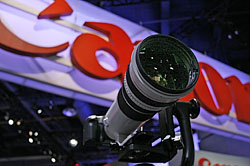
The Vision Thing
This year marks the 20th anniversary of the Canon EOS camera line. Canon invited about 200 members of the press and industry analysts to a dinner at the Venetian hotel Thursday evening to celebrate.
Before sitting down for dinner, Canon President and CEO Yoroku "Joe" Adachi mingled with the guests, discussing the importance of the "culture of photography" and the company's commitment to giving something back. He noted that "the customer is king -- or queen" making all the decisions about what happens in this business.
Canon has assembled an array of its classic camera models on the show floor, a few of which we photographed for a small Web gallery (http://www.imaging-resource.com/EVENTS/PMAS07mrp/gal-canon/).